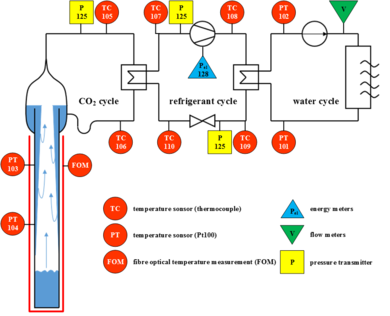At present, just under 30% of primary energy consumption in Germany is used to generate space heating. One source of thermal energy that has been very little used to date is the ground. Geothermal probes are used to extract heat from the earth. A particularly efficient variant of geothermal probes is the CO2 phase change probe. Simulations verified by measurements are used to better understand the heat and mass transfers occurring in the probe.So-called geothermal probes are used to extract heat from the earth, which is raised to a usable temperature level in a heat pump and then passed on to a heating circuit. These probes exploit the phenomenon that the temperature of the ground increases with increasing depth. In addition to single-phase probes, which are operated with a mixture of water and glycol and can only store sensible heat, the phase change probe is a more energy-efficient and effective alternative to heat extraction. These probes consist of a closed tube filled with a working fluid at boiling point. At the head of the probe, the working fluid is condensed by heat extraction, causing it to flow down the inner wall of the probe. On its way down, the working fluid absorbs energy from the soil by heat conduction and evaporates. This heat transfer is very effective due to the high heat transfer coefficient during vaporization. The vaporous working fluid then rises inside the probe and is available again for condensation at the head of the probe.The operating behavior of these phase change probes depends on boundary conditions such as the pipe material used, the geometry of the pipe used, the working medium used and the level of the probe. Furthermore, the operating mode of the probes plays an important role. To improve the efficiency of these systems, an in-depth understanding of the heat and mass transfers in the probe is necessary. For this purpose, measurements are carried out on existing probes, which are then used to improve the numerical simulation of the operating behavior of these probes. A fiber-optic temperature measurement technique is used here, which makes it possible to determine the temperature on the outer wall of the probes over the entire depth. Based on these temperatures and the temperature change, conclusions can be drawn about the condition inside the probes.


 ©
IfT, Leibniz Universität Hannover
©
IfT, Leibniz Universität Hannover


 ©
IfT, Leibniz Universität Hannover
©
IfT, Leibniz Universität Hannover
Processing


30823 Garbsen




